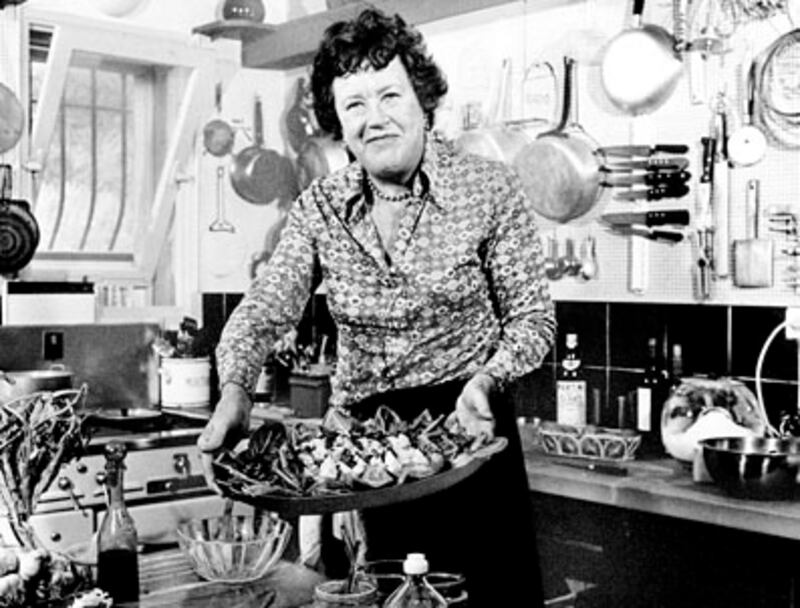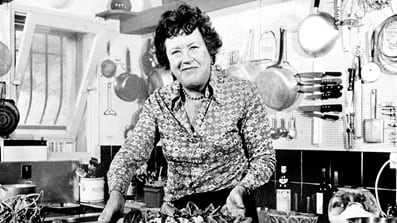
I met Julia Child over profiteroles du chocolat at the Cipriani in Venice. I was late. My plane from London had been delayed by a couple of hours and I arrived at the hotel just in time for dessert. I thought I could slip unnoticed into a vacant place at the long, lavishly appointed table and introduce myself to the assembled guests after dinner, but as the waiter proffered the luscious chocolate confection, I heard a familiar throaty voice from the center of the throng. “Welcome,” said Julia Child, as only Julia Child can say it. “We’re all very glad you are here.”
I was too. In fact I was thrilled. I was “here” on a dream assignment—to spend a week at one of the most luxurious hotels imaginable and write a story about the doyenne of French cuisine as she explored and demonstrated the nuances of Italian cookery. (She later explained this was really not her forte, but she forged ahead with her usual gusto.) It was the last week of October 1996 and this tony pre-class get together—a five-course, five-wine banquet—was the first chance for the collection of 40 well-heeled, well-dressed gastronomes from around the globe to mix and mingle with the fabled chef.
When a guest chef tried to stitch up a guinea hen with a giant needle and several feet of string, she rolled her eyes and quipped, “OOOOOH, you’re sewing it up like an old sofa pillow.”
The indefatigable octogenarian did not disappoint. Cordial, erect, immaculately coiffed and made up, she circulated late into the night, chatting up everyone, asking questions and brimming with enthusiasm. This stamina and spontaneity set the pattern for the five hectic days ahead.
At 9 the next morning, as I fastened my starched white Cipriani apron and sipped espresso from a dainty porcelain cup, I realized this was no ordinary cooking class at a posh hotel. It was a happening, a celebration of “La Julia,” as the Italians called her, who dished up advice along with bonhomie and cheer. She was also a kibitzer extraordinaire. There were many amusing gaffes and Julia was always ready with a riposte. When a guest chef tried to stitch up a guinea hen with a giant needle and several feet of string, she rolled her eyes and quipped, “OOOOOH, you’re sewing it up like an old sofa pillow.”
Improbable as it sounds, we connected over the intricacies of pasta-making, a basic skill students repeated almost every day. This is not easy to do, I was not a stellar pupil and though Julia kept telling me to knead the immovable dough, to stretch it out by shoving it with the heels of my hands, I was not up to the task.
She sighed, looked at me with the same look I had seen her give a dead duck on her TV show, The French Chef, and ever so politely suggested perhaps I was a bit of a klutz . I agreed. We both started to laugh and continued to do so throughout the rest of the trip, which included a variety of grand excursions, including a visit to a magnificent estate in Padua, where we dined in a 14th-century wine cellar, and an early-morning sortie to the Rialto—the picturesque open-air fish market in the heart of Venice. The latter was her ultimate teaching moment. With the entire class of foodies trailing in her wake, the revered cuisiniere roamed the fish stalls, poking and prodding marine delicacies, delighting in the cornucopia of eels, mollusks, and spongy octopi. “Look,” she enthused, flipping over several red-eyed mullets, “these are so fresh rigor mortis has not yet set in.”
I had an immediate flashback to that memorable outing when I saw Julie & Julia, in which Meryl Streep plays, or should I say morphs into, Julia Child. There is an evocative scene in the movie when Julia, an aspiring cook, ambles through a Parisian market in the late 1940s, savoring cheese and bread and grappling with a mammoth, wriggling eel.
It’s eerie to watch Streep in the role. It’s not just the plummy voice and the perfect diction she has down pat, it’s all the little gestures: the shoulder shrugs, the determined stride, along with Julia’s insouciance and wry sense of humor.
The highlight of my trip was getting to know the iconic woman whom Time once dubbed “Our Lady of the Ladle.” One night, after another of our many sumptuous feeds, we settled in the cozy hotel bar and as she downed several of her favorite “reverse martinis,” we talked. I learned she was a cancer survivor. She had undergone a mastectomy at 51. She reminisced about her beloved late husband, Paul, who introduced her to the world of fine food and wine when he brought her to Paris in the 1940s. (It was her first lunch, a delicious sole meuniere, that captured her imagination and launched her illustrious career.)
She was purist, an advocate of portion control, and a devotee of what she called “real food,” meaning meat, butter, cream, eggs and, of course, gin. “Everything in moderation,” was her mantra. “You can eat anything you want,” she told me over and over, “you just have to eat a little bit of each thing.” From then on, I carefully watched her plate. She always stuck to this rule. I’ve passed it along for years. Restraint is a virtue—impossible to do.
She was also extremely savvy about her profession. “If you’re not in the public eye, people forget you—if you can’t take the heat, get out of the oven.”
After I received my diploma at an over-the-top graduation dinner in a fabulous palazzo on the Grand Canal, we stayed in touch. From time to time, I would receive a red-bordered postcard typed by Julia’s assistant. Around the edges in her own spidery scrawl she would ask how I was. Had I been on a trip? And what was going on in DC?
When she came to town, we would have lunch or a drink. Often she included me in festivities in her honor.
Once when she spoke at a luncheon at the National Press Club, she did not consume a bite. The food was so awful that she grabbed me after the event and we went across the street to the Willard Hotel to eat and catch up.
When she decided to leave her house in Cambridge, Massachusetts, for retirement to Santa Barbara, she sent the particulars with a note explaining the cold had finally gotten to her bones.
She died there in 2004, two days before her 92nd birthday.
It’s a cliché to say I was lucky to know her, but it’s true. She was always interested in my life and there was not a phony bone in her body. A rarity in this world of narcissists and super-egos.
During one of our conversations she told me, “I’ve always been an enthusiast and, I hope, a spurrer on-er.”
She was. Still is.
Sandra McElwaine is a Washington-based journalist. She has been a reporter for The Washington Star, The Baltimore Sun, a correspondent for CNN and People and Washington editor of Vogue and Cosmopolitan. Currently she writes for The Washington Post, Time and Forbes.






